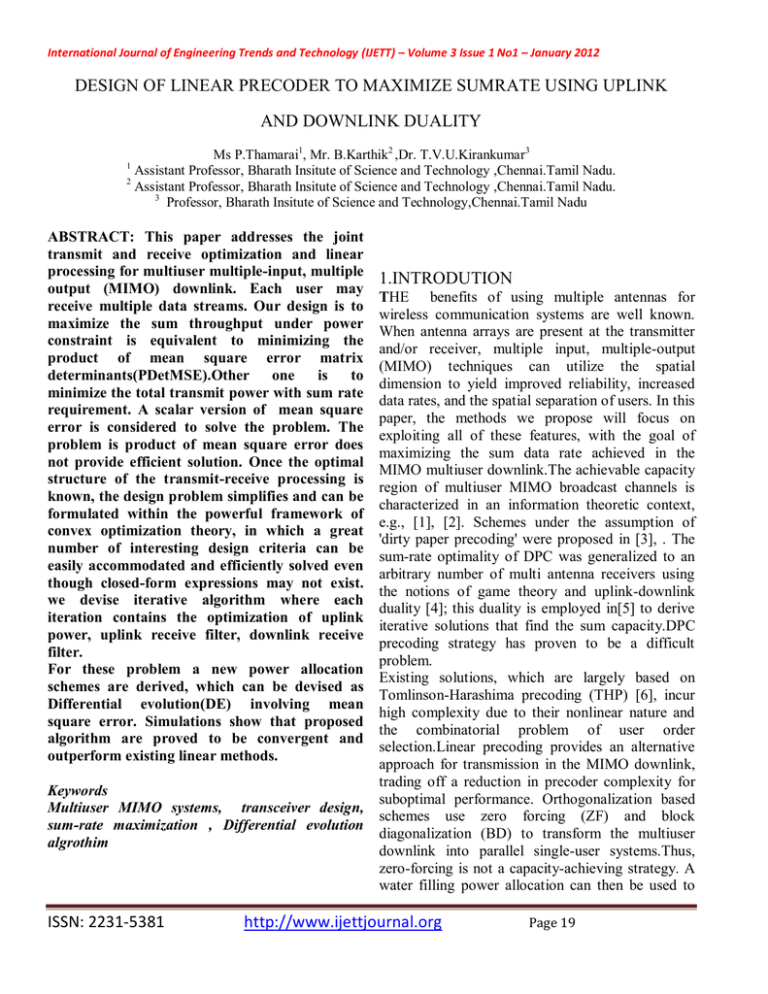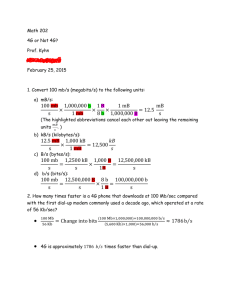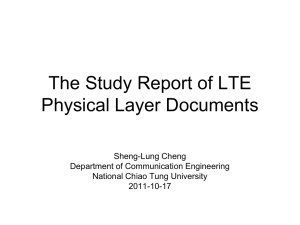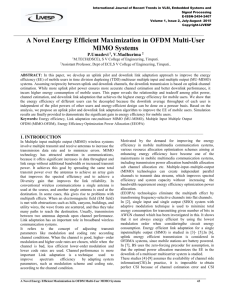Document 12908545
advertisement

International Journal of Engineering Trends and Technology (IJETT) – Volume 3 Issue 1 No1 – January 2012
DESIGN OF LINEAR PRECODER TO MAXIMIZE SUMRATE USING UPLINK
AND DOWNLINK DUALITY
Ms P.Thamarai1, Mr. B.Karthik2 ,Dr. T.V.U.Kirankumar3
Assistant Professor, Bharath Insitute of Science and Technology ,Chennai.Tamil Nadu.
2
Assistant Professor, Bharath Insitute of Science and Technology ,Chennai.Tamil Nadu.
3
Professor, Bharath Insitute of Science and Technology,Chennai.Tamil Nadu
1
ABSTRACT: This paper addresses the joint
transmit and receive optimization and linear
processing for multiuser multiple-input, multiple
output (MIMO) downlink. Each user may
receive multiple data streams. Our design is to
maximize the sum throughput under power
constraint is equivalent to minimizing the
product of mean square error matrix
determinants(PDetMSE).Other one
is
to
minimize the total transmit power with sum rate
requirement. A scalar version of mean square
error is considered to solve the problem. The
problem is product of mean square error does
not provide efficient solution. Once the optimal
structure of the transmit-receive processing is
known, the design problem simplifies and can be
formulated within the powerful framework of
convex optimization theory, in which a great
number of interesting design criteria can be
easily accommodated and efficiently solved even
though closed-form expressions may not exist.
we devise iterative algorithm where each
iteration contains the optimization of uplink
power, uplink receive filter, downlink receive
filter.
For these problem a new power allocation
schemes are derived, which can be devised as
Differential evolution(DE) involving mean
square error. Simulations show that proposed
algorithm are proved to be convergent and
outperform existing linear methods.
Keywords
Multiuser MIMO systems, transceiver design,
sum-rate maximization , Differential evolution
algrothim
ISSN: 2231-5381
1.INTRODUTION
THE benefits of using multiple antennas for
wireless communication systems are well known.
When antenna arrays are present at the transmitter
and/or receiver, multiple input, multiple-output
(MIMO) techniques can utilize the spatial
dimension to yield improved reliability, increased
data rates, and the spatial separation of users. In this
paper, the methods we propose will focus on
exploiting all of these features, with the goal of
maximizing the sum data rate achieved in the
MIMO multiuser downlink.The achievable capacity
region of multiuser MIMO broadcast channels is
characterized in an information theoretic context,
e.g., [1], [2]. Schemes under the assumption of
'dirty paper precoding' were proposed in [3], . The
sum-rate optimality of DPC was generalized to an
arbitrary number of multi antenna receivers using
the notions of game theory and uplink-downlink
duality [4]; this duality is employed in[5] to derive
iterative solutions that find the sum capacity.DPC
precoding strategy has proven to be a difficult
problem.
Existing solutions, which are largely based on
Tomlinson-Harashima precoding (THP) [6], incur
high complexity due to their nonlinear nature and
the combinatorial problem of user order
selection.Linear precoding provides an alternative
approach for transmission in the MIMO downlink,
trading off a reduction in precoder complexity for
suboptimal performance. Orthogonalization based
schemes use zero forcing (ZF) and block
diagonalization (BD) to transform the multiuser
downlink into parallel single-user systems.Thus,
zero-forcing is not a capacity-achieving strategy. A
water filling power allocation can then be used to
http://www.ijettjournal.org
Page 19
International Journal of Engineering Trends and Technology (IJETT) – Volume 3 Issue 1 No1 – January 2012
allocate powers to each of the users [7]. It is also
possible to improve the sum rate achieved with ZF
and BD by including user or antenna selection in
the precoder design. In this paper, we consider the
optimal formulation for sum rate maximization
under linear precoding. Much of the existing
literature on linear precoding for multiuser MIMO
systems focuses on minimizing the sum of mean
squared errors (SMSE) between the transmitted and
received signals under a sum power constraint [8]–
[9]. An important recurring theme in most of these
papers is the use of an uplink-downlink duality for
both MSE and signal-to interference-plus-noise
ratio (SINR) introduced in [10] for the single
receive antenna case and extended to the MIMO
case in [11].
Linear precoding approaches an iterative method
for direct optimization of the sum rate, while [13]
and [14] exploit the SINR uplink-downlink duality
of [10], [11]. In [16][17] two similar algorithms
were independently proposed to minimize the
product of the mean squared errors (PMSE) in the
multiuser MIMO downlink; these papers showed
that the PMSE minimization problem is equivalent
to the direct sum rate maximization proposed in
[14]. The work of [15] was motivated by the
equivalence relationship developed between the
single user minimum MSE (MMSE) and mutual
information in [18]. Each of the approaches in [12]
yields a suboptimal solution, as the resulting
solutions converge only to a local optimum, if at
all.
It has been shown that with linear processing the
above problems are non-convex, thus known
algorithms for determinant maximization can not be
applied[19]. Here, we propose iterative algorithms
to jointly optimize the transmit powers, transmit and
receive filters, which are suitable for both uplink
and downlink transmission, based on the
uplink/downlink duality[20].
Notation: Lower case italics, e.g., x, represent
scalars while lower case boldface type is used for
vectors (e.g., x). Upper case italics, e.g., N , are
used for constants and upper case boldface
represents matrices, e.g., X. Entries in vectors and
matrices are denoted as [x]i and [X]i,jrespectively.
The superscripts T and H denote the transpose and
ISSN: 2231-5381
Hermitian operators. E[.] represents the statistical
expectation operator while IN is the N N identity
matrix. tr [.] and det are the trace and determinant
operators. x 1 and x 2 denote the 1- norm (sum of
entries) and Euclidean norm. diag(x) represents the
diagonal matrix formed using the entries in vector
x.
2.SYSTEM MODEL
We consider a standard multiuser MIMO downlink
model with NT transmit antennas at base station and
K decentralized receivers, each with N RK receive
antennas. Assume that independent unit- power
symbols d=[d1,…..dK]T
with E{ddH}=I, are
Mk X 1
transmitted, where dk Є C
is the data vector to
be transmitted to a Kth mobile. The total number of
transmit data streams is
Zero
mean white Gaussian noise is denoted by
n=[n1,……,nk] ~N(0, σ2n I). These transmitter
precoder matrix U = [U1,. . . ,UK] Є CNT X Nd .The
downlink transmit power vector for user k be pk =
[pk1, . . . , pNd ]T with P = diag{p}. .The channel
matrix is HH, with H = [H1, . . . ,HK] CNT X NRk .The
uplink transmit power vector for user k be qk =[qk1,
. . . , qNd ]T with Q = diag{q}. Based on this model,
user k receives a length-Nk vector
Yk= Hk
H
UPk+nk ,
(1)
The global receive filter AH is a block diagonal
matrix of dimension Mk × NRK,
http://www.ijettjournal.org
Page 20
International Journal of Engineering Trends and Technology (IJETT) – Volume 3 Issue 1 No1 – January 2012
A= diag[A1, · · · ,AK], where each Ak =[Ak1, . . . , fixed U are both non-convex problems and are just
ANd].Estimate signal
as difficult to solve as the rate maximization
problem. While it is well accepted that the power
DL
H
H
H
allocation sub problem in PMSE minimization is
Ŝk = Ak Hk U
sk+ Ak nk ,(2)
non-convex [18], recent work [17]has shown that
DL
where the superscript
indicates the downlink. the optimal power allocation can be found by
The MSE matrix for user k in the downlink under formulating the sub problem as a Differential
these general precoder and decoder matrices can be Evolution algorithm problem [19].
written as
3.OPTIMIZATION ALGORTHIM
DL
H
E k = V k Hk
H
UkPK -Vk Hk
H
H
H
2
H
UPK U HkVk+ σ V
UkHPK + ILk ,
k
H
Vk - V
k
Hk
2.1Product of MSE matrix determinants:
In this section, we show that an MSE-based
formulation using joint processing of all streams
leads to an equivalent optimal formulation of the
rate maximization problem under linear processing.
First, consider the linear MMSE decoder for user k,
Ak
Ak =( HHkUPkUHk Hk+σ2I)-1HkHUPk ,
(3)
3.1 Uplink and Downlink MMSE Receive Filters:
In this subsection, we give a short review of the
uplink and downlink MMSE receive filters with
fixed transmit filters in both links. For convenience,
we define
Ũk=Ukβk=(HAPVHHH+σ2nI)-1HkAkPk,
(6)
The diagonal matrix βk contains the column norms
of Ũk . Similarly, for the downlink channel, the
MMSE receive filters are given as TK QK-1/2 , where
When using this matrix as the receiver in (1), the
downlink MSE matrix for user k in can be
simplified as
Ãk=Akβk=(HkHUQUHHk+σ2nI)-1HkHUkQk, (7)
The diagonal matrix βk contains the column norms
of Ãk .
EkDL =Ik- PK UHk HkJk -1 Hk
3.2 Optimization in Virtual Downlink Channel:
Defining diagonal matrix[D]= βi uHiHtHi ti HH ui-2
Re{uHiH ti }+1 and a matrix
[Ψ]ij={uHitjtHjHHui,
i≠j
0,
i=j
H
Uk,
(4)
where Jk = HHk U Pk UH Hk + σ2I and RN+I,k = Jk
−HHkUkPkUHkHk are the received signal covariance
matrix and the noise-plus-interference covariance
matrix at user k, respectively.
With this result, we can see that under MMSE
reception using Ak as defined in (3), minimizing the
determinant of the MSE matrix EDLk is equivalent
to maximizing the achievable rate for user k. It
follows that minimizing the product of MSE matrix
determinants over all users is equivalent to sum rate
maximization,
According to MSE duality, we know that the same
MSE values us in the uplink can be achieved in the
downlink, with appositive power allocation
p = σn2( ε-D-β2 𝛹T)-1 β2 1Nd ,
(8)
With the downlink power allocation=diag{q}, and
transmit filter U, the MSE can be minimized by
downlink MMSE receive filters AkβkQk-1/2, where
min
≡ min
Ak, βk are computed with (7).Additionally, again in
≡ min
(5)
the uplink, the power allocation first ensures the
same performance as in the downlink, which can be
The covariance matrices Jk and RN+I,k in the MSE
obtained by
matrix Ek are each functions of all precoder and
q = σn2( ε-D-β2 𝛹)-1 β2 1Nd ,
(9)
power allocation matrices. As such, finding U and P
jointly or finding only the power allocation P for a
ISSN: 2231-5381
http://www.ijettjournal.org
Page 21
International Journal of Engineering Trends and Technology (IJETT) – Volume 3 Issue 1 No1 – January 2012
3.3 Optimization in Virtual Uplink Channel:
Under an assumption of minimum Euclidean
distance decoding and Gaussian signaling, there is a
one-to-one monotonic relationship between
achievable rate (in bits per channel use) and SINR.
Ri=log2(1+SINR),
The power optimization problem can be formulated
as a Differential Evolution algorithm problem
Algroithm:
1. Initialize[Ut,St,Vk]=svd(Hk),Ak=Vk,
Q=Qmax/K/Nr and maximal number
of iterations nmax .
2. Compute uplink receive filters Uk and
βk ,with (7) .
min
q
(10)
DE ALGORTHIM
Initialization
Evaluation
Repeat
Mutation
Selection
Until the required accuracy met
ISSN: 2231-5381
4. n ← n+1 .
5. Uplink Channel:
The DE algorithm is a population based algorithm
like genetic algorithms using the similar operators;
crossover, mutation and selection. The main
difference in constructing better solutions is that
genetic algorithms rely on crossover while DE
relies on mutation operation. This main operation is
based on the differences of randomly sampled pairs
of solutions in the population. The algorithm uses
mutation operation as a search mechanism and
selection operation to direct the search toward the
prospective regions in the search space. The DE
algorithm also uses a non-uniform crossover that
can take child vector parameters from one parent
more often than it does from others. By using the
components of the existing population members to
construct trial vectors, the recombination
(crossover) operator efficiently shuffles information
about successful combinations, enabling the search
for a better solution space.
An optimization task consisting of D parameters
can be represented by a D-dimensional vector. In
DE, a population of NP solution vectors is
randomly created at the start. This population is
successfully improved by applying mutation,
crossover and selection operators.
The main steps of the DE algorithm is given below:
a.
b.
c.
d.
e.
f.
3. repeat
a. For given Ak(n-1) , Uk(n-1) , and βk(n-1),
find optimum power allocation q by
solving (9).
b. Update Uk(n) , βk(n) , with (7).
6.
Downlink Channel:
a. Compute P(n) , with (10).
b. Update Ak(n) , βk(n) , with(8).
7. Uplink Channel:
a. Compute Q(n) , with (11).
b. Update Uk(n) , βk(n) , with(7).
8. Until required accuracy is reached.
IV.SIMULATION RESULTS
The PMSE and PDetMSE algorithms do not require
the explicit selection of Nd; rather, this parameter is
determined implicitly by the power allocation.
However, we can force the PMSE algorithm to
allocate a maximum number of substreams Nd to
each user to gain further insight into its behaviour.
In Fig. 5, the number of streams in the Nd = 4
system described below is varied from x1 = x2 = 2
to x1 = 3 and x2 = 1. The achievable sum rate in this
system decreases in the latter case, as the
asymmetric stream allocation does not correspond
to the symmetric channel configuration.
http://www.ijettjournal.org
Page 22
International Journal of Engineering Trends and Technology (IJETT) – Volume 3 Issue 1 No1 – January 2012
processing
solution
based
on
PDetMSE
minimization was shown to be theoretically
optimal, but computationally infeasible. A
suboptimal framework based on scalar processing
was then proposed, and an implementation was
provided based on PMSE minimization We propose
iterative algorithms based on MSE duality and
Differential evolution. Unlike the power control by
DE with respect to SINR, we propose a new power
control strategy by optimizing geometric MSE
together with MMSE estimation. The algorithms are
proved to be convergent.
REFERENCES
Power
[1] G. Caire and S. Shamai (Shitz), “On the
achievable throughput of a multiantenna Gaussian
POWER MINIMIZATION FOR TX =4,USER=2,REV=2
broadcast channel,” IEEE Trans. Inform.
10
Theory,vol. 49, no. 7, pp. 1691–1706, July 2003.
9
[2] W. Yu and J. M. Cioffi, “Sum capacity of
8
Gaussian vector broadcast channels,” IEEE Trans.
7
Inform. Theory, vol. 50, no. 9, pp. 1875–1892,Sept.
6
2004.
5
[3] M. Costa, “Writing on dirty paper,” IEEE Trans.
4
Inform. Theory, vol. 29,no. 3, pp. 439–441, May
3
1983.
[4] S. Vishwanath, N. Jindal, and A. Goldsmith,
2
“Duality, achievable rates, and sum-rate capacity of
1
Gaussian MIMO broadcast channels,” IEEE Trans.
0
0
2
4
6
8
10
12
14
16
18
20
Inform. Theory, vol. 49, no. 10, pp. 2658–2668,
Iteration
Oct. 2003.
In this case, user 2 is restricted to only a single data
[5] P. Viswanath and D. N. C. Tse, “Sum capacity
stream, and thus can not take full advantage of good
of the vector Gaussian broadcast channel and
channel realizations. If the goal is always,
uplink-downlink duality,” IEEE Trans. Inform.
maximizing the sum rate, the users should be
[6] C. Windpassinger, R. F. H. Fischer, T. Vencel,
allocated the maximum number of data streams in
and J. B. Huber, “Precoding in multiantenna and
as balanced a manner as possible.
multiuser communications,” IEEE Trans. Wireless
Commun., vol. 3, no. 4, pp. 1305–1336, July 2004.
CONCLUSIONS
[7] Q. H. Spencer, A. L. Swindlehurst, and M.
we have considered the problem of designing a Haardt, “Zero-forcing methods for downlink spatial
linear precoder to maximize sum throughput in the multiplexing in multi-user MIMO channels, ”IEEE
multiuser MIMO downlink under a sum power Trans. Signal Processing, vol. 52, no. 2, pp. 461–
constraint. We have compared the maximum 471, Feb. 2004.
achievable sum rate performance of linear [8] A. J. Tenenbaum and R. S. Adve, “Joint
precoding schemes to the sum capacity in the multiuser transmit-receive optimization using linear
general
processing,” in Proc. IEEE Internat. Conf. on
MIMO downlink. The problem was reformulated in Communications (ICC 04), vol. 1, Paris, France,
terms of MSE based expressions, and the joint June 2004, pp. 588–592.
ISSN: 2231-5381
http://www.ijettjournal.org
Page 23
International Journal of Engineering Trends and Technology (IJETT) – Volume 3 Issue 1 No1 – January 2012
[9] A. Mezghani, M. Joham, R. Hunger, and W.
Utschick, “Transceiver design for multi-user MIMO
systems,” in Proc. ITG/IEEE Workshop on Smart
Antennas, Ulm, Germany, Mar. 2006.
[10] M. Schubert and H. Boche, “Solution of the
multiuser downlink beamforming problem with
individual SINR constraints,” IEEE Trans.
Veh.Technol., vol. 53, no. 1, pp. 18–28, Jan. 2004.
[11] M. Schubert, S. Shi, E. A. Jorswieck, and H.
Boche,
“Downlink
sum-MSE
transceiver
optimization for linear multi-user MIMO systems,”
inProc. Asilomar Conf. on Signals, Systems and
Computers, Monterey,CA, Sept. 2005, pp. 1424–
1428.
[12] M. Stojnic, H. Vikalo, and B. Hassibi, “Rate
maximization in multiantenna broadcast channels
with linear preprocessing,” IEEE Trans.Wireless
Commun., vol. 5, no. 9, pp. 2338–2342, Sept. 2006.
[13] D. A. Schmidt, M. Joham, R. Hunger, and W.
Utschick, “Near maximum sum-rate non-zeroforcing linear precoding with successive
userselection,” in Proc. Asilomar Conf. on Signals,
Systems and Computers, Oct. 2006, pp. 2092–2096.
[14] M. Codreanu, A. T¨ olli, M. Juntti, and M.
Latva-aho, “Joint design of Tx-Rx beamformers in
MIMO downlink channel,” IEEE Trans. Signal
Processing, vol. 55, no. 9, pp. 4639–4655, Sept.
2007.
[15] A. J. Tenenbaum and R. S. Adve, “Sum rate
maximization using linear precoding and decoding
in the multiuser MIMO downlink,” Sept. 2006.
[16] A. M. Khachan, A. J. Tenenbaum, and R. S.
Adve, “Linear processing for the downlink in
multiuser MIMO systems with multiple data
streams,” in Proc. IEEE Internat. Conf. on
Communications (ICC 06),
Istanbul, Turkey, June 2006.
[17] S. Shi, M. Schubert, and H. Boche, “Weighted
sum-rate optimization for multiuser MIMO
systems,” in Proc. Conf. Info. Sciences and Systems
(CISS ’07), Mar. 2007, pp. 425–430.
[18] D. Guo, S. Shamai, and S. Verdu, “Mutual
information and minimum mean-square error in
Gaussian channels,” IEEE Trans. Inform.
Theory,vol. 51, no. 4, pp. 1261–1282, Apr. 2005.
ISSN: 2231-5381
[19] A Simple and Global Optimization Algorithm
for Engineering problems: Differential Evolution
Algorithm.
[20] S. Boyd and L. Vandenberghe, Convex
Optimization. Cambridge University Press, 2004.
http://www.ijettjournal.org
Page 24







